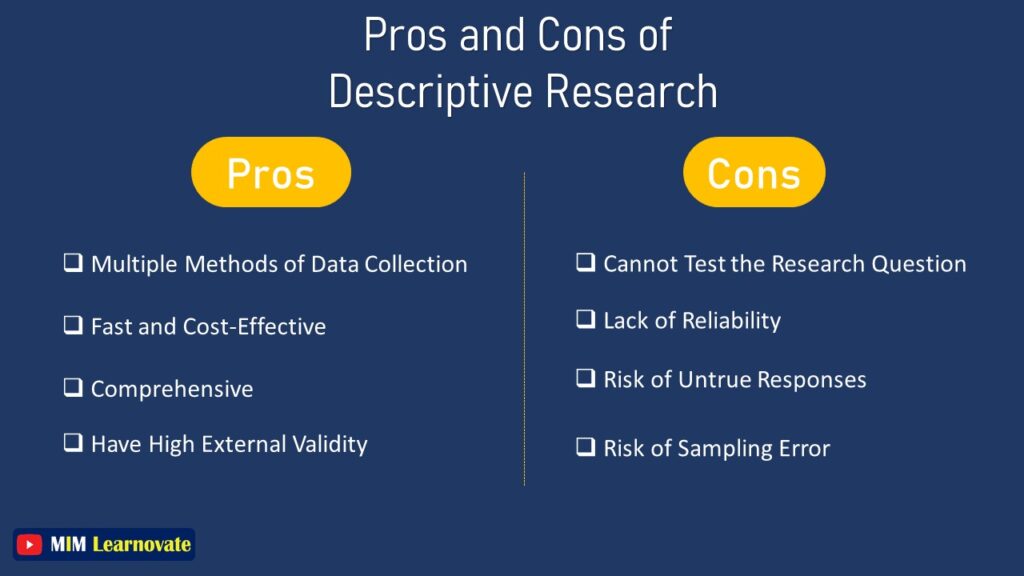Study designs: Part 2 Descriptive studies PMC
Table Of Content

The Head Start Family and Child Experiences Survey and the Early Childhood Longitudinal Study Program have provided researchers, policy makers and practitioners with rich information about school readiness skills of children in the U.S. In this stage, you will have to identify which tools and techniques are relevant and valid to your study. Leverage robust survey software that offers you multiple channels, thus enabling you to utilize various channels to gather insights. The first step is to identify and outline the objectives of your research and then translate these objectives into criteria of investigation. You must clearly identify the different issues and questions in the context of which the knowledge of the situation must be surveyed.
Utilizing Blogs on ESL learners' vocabulary learning through social constructivist theory: A descriptive study - ScienceDirect.com
Utilizing Blogs on ESL learners' vocabulary learning through social constructivist theory: A descriptive study.
Posted: Fri, 16 Dec 2022 09:05:36 GMT [source]
Descriptive research allows for cross sectional study
Using qualitative descriptive research in this manner can help to make the findings of intervention studies more clinically meaningful. Qualitative descriptive designs are common in nursing and healthcare research due to their inherent simplicity, flexibility and utility in diverse healthcare contexts. However, the application of descriptive research is sometimes critiqued in terms of scientific rigor.
Appendix A. Music Therapy Assessment Survey Questions
In the data collection stage, you must have a clear plan of how your data will be collected. This involves clearly outlining the type of data you require, the tools that will be used to gather it, the level of training required by researchers to collect the data, the time required for data collection and fieldwork, and so on. As with any research study, the application of descriptive methods will emerge in response to the aims and objectives, which will influence the sampling, data collection and analysis phases of the study. The observational method allows researchers to collect data based on their view of the behaviour and characteristics of the respondent, with the respondents themselves not directly having an input.
Article Level Metrics
More specifically, it helps answer the what, when, where, and how questions regarding the research problem rather than the why. Annemarie Brady (PhD, MSc, BNS, RNT, RPN) is Chair of Nursing and Chronic Illness and Head of School of Nursing and Midwifery at Trinity College Dublin. Her research work has focused on the development of healthcare systems and workforce solutions to respond to increased chronic illness demands within healthcare. She has conducted a range of mixed-method research studies in collaboration with health service providers to examine issues around patient-related outcomes measures, workload measurement, work conditions, practice development, patient safety and competency among healthcare workers.
Survey
For example, many authors reported that study objectives were to describe orexplore participants’ experiences and factors related to certain phenomena, events,or interventions. In most cases, these authors cited Sandelowski (2000) as a reference for this particular characteristic. It was rarethat theoretical or philosophical frameworks were identified, which also is consistent withdescriptions of QD.
Qualitative coding can be used to identify common themes, patterns, or categories within the data. Nutrients and food supplements are widely used worldwide [2, 6, 7] for health protection and treatment of chronic diseases [10]. For the same reasons, patients often prefer to use nutrients and food supplements during their surgical period [23, 92].
Clearly define the research question
Ethical standards were reported in greater than 89% ofall articles and most articles included an in-depth description of data analysis(83.6%) and development of categories or themes (92.7%). Finally, allresearchers clearly stated their findings in relation to research questions/objectives.Researchers of 83.3% of the articles discussed the credibility of their findings(see Table 1). As we did not intend toidentify trends in QD approaches over time, it seemed reasonable to focus on the nursingQD studies published in a certain year. The inclusion criterion for this review wasdata-based, nursing-related, research articles in which authors used the terms QD,qualitative descriptive study, or qualitative descriptive design in their titles orabstracts as well as in the main texts of the publication. This questionnaire-interview was designed for this study by the researchers utilizing the literature (Supplementary Material).
What is Descriptive Research Design Used For?
Quantitative experiments are often expensive and time-consuming so it is often good sense to get an idea of what hypotheses are worth testing. A good example of this would be an anthropologist who wanted to study a tribe without affecting their normal behavior in any way. True experiments, whilst giving analyzable data, often adversely influence the normal behavior of the subject. Descriptive research is primarily concerned with providing an objective representation of the subject of study without explaining underlying causes or mechanisms. Explanatory research seeks to explain the relationships between variables and uncover the underlying causes or mechanisms. Experimental research typically involves randomly assigning participants to different groups, such as control and experimental groups, and measuring the outcomes.
Characteristics of Descriptive Research
The sample calculation of the study was made with 50% unknown frequency and 95% confidence interval with type 1 error 0.05, and it was calculated that at least 307 participants should be reached. When the sample size was stratified separately for doctors and nurses, it was found that 140 doctors and 167 nurses needed to be reached. Criteria for inclusion in the study; working as a staff doctor or nurse in surgical clinics, volunteering to participate in the research, working in adult surgical clinics. Doctors and nurses working in hospitals do not receive training in nutrients and food supplements. In conclusion, it was found that the level of knowledge of nutrients and food supplements among doctors and nurses working in surgical clinics was less than half or even close to zero. Nutrients and food supplements frequently used in the surgical period may cause complications and side effects.
Inferential research, however, involves making inferences or generalizations about a larger population based on a smaller sample. Before going into the differences between descriptive and correlation research, we need to have a proper understanding of what correlation research is about. Descriptive research is conducted over some time to ascertain the changes observed at each point in time. The higher the number of times it is conducted, the more authentic the conclusion will be. For example, a survey evaluating the number of hours millennials in a community spends on the internet weekly, will help a service provider make informed business decisions regarding the market potential of the community. This is because it provides basic information about the research problem, which may give birth to other questions like why a particular thing is the way it is.
A researcher who wishes to classify the sea animals into different species will collect samples from various search stations, then classify them accordingly. A survey will be carried out to gather enough data about the income of the employees, then their performance will be evaluated and compared to their income. This will help determine whether a higher income means better performance and low income means lower performance or vice versa. For example, an investor considering an investment in the ever-changing Amsterdam housing market needs to understand what the current state of the market is, how it changes (increasing or decreasing), and when it changes (time of the year) before asking for the why. Surveys are useful because they don't take as long as an observational study since you're asking people about themselves instead of spending weeks observing them. On the other hand, if the person doesn't know very much about themselves or if they lie, then you run into a problem.

It is also useful where it is not possible to test and measure the large number of samples needed for more quantitative types of experimentation. Many scientific disciplines, especially social science and psychology, use this method to obtain a general overview of the subject. In this article we’ll look at the different types and characteristics of extrapolation, plus how it contrasts to interpolation. In this article, we’ll look at what cross-sectional studies are, how it applies to your research and how to use Formplus to collect...
In this study, it was found that the overall success scores of doctors and nurses in relation to nutrients and food supplements and the success scores in relation to complications and side effects increased statistically significantly with increasing age. In addition, total success scores, success scores related to complications and side effects, and success scores related to drug interactions of nutrients and food supplements increased statistically significantly with increasing years of employment. The results of our study suggest that the experience of doctors and nurses with increasing age and years of employment may contribute positively to the level of knowledge about nutrients and food supplements. A systematic review was conducted by examining QD research articles focused onnursing-related phenomena and published in one calendar year.
However, the conundrum facing researchers who wish to use this approach is its lack of visibility and transparency within methodological papers and texts, resulting in a deficit of available information to researchers when designing such studies. By adding to the existing knowledge base, this paper enhances the information available to researchers who wish to use the qualitative descriptive approach, thus influencing the standard in how this approach is employed in healthcare research. As seen in our paper, qualitative descriptive studies have a role in healthcare research providing insight into service users and providers’ perceptions and experiences of a particular phenomenon, which can inform healthcare service provision. In general, the overall characteristics were consistent with design features of QDstudies described in the literature (Neergaard et al.,2009; Sandelowski, 2000, 2010; Vaismoradi et al.,2013).
It is often used in market research, psychology, and some other social science research to understand human behaviour. There are 3 main data collection methods in descriptive research, namely; observational method, case study method, and survey research. Indeed, the investigators in the myopia study above visited the same children and reassessed them a year later. This separate follow-up study[8] showed that “new” myopia had developed in 3.4% of children (incidence rate), with a mean change of −1.09 ± 0.55 D. Among those with myopia at the time of the initial survey, 49.2% showed progression of myopia with a mean change of −0.27 ± 0.42 D.
Comments
Post a Comment